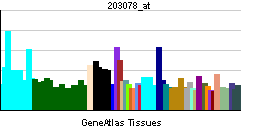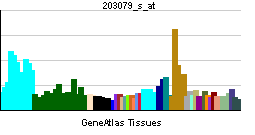CUL2
| Cullin 2 | |||||||||
|---|---|---|---|---|---|---|---|---|---|
| Identifiers | |||||||||
| Symbols | CUL2 ; MGC131970 | ||||||||
| External IDs | Template:OMIM5 Template:MGI HomoloGene: 2662 | ||||||||
| |||||||||
| RNA expression pattern | |||||||||
 | |||||||||
 | |||||||||
| More reference expression data | |||||||||
| Orthologs | |||||||||
| Template:GNF Ortholog box | |||||||||
| Species | Human | Mouse | |||||||
| Entrez | n/a | n/a | |||||||
| Ensembl | n/a | n/a | |||||||
| UniProt | n/a | n/a | |||||||
| RefSeq (mRNA) | n/a | n/a | |||||||
| RefSeq (protein) | n/a | n/a | |||||||
| Location (UCSC) | n/a | n/a | |||||||
| PubMed search | n/a | n/a | |||||||
Cullin 2, also known as CUL2, is a human gene.[1]
References
Further reading
- Kibel A, Iliopoulos O, DeCaprio JA, Kaelin WG (1995). "Binding of the von Hippel-Lindau tumor suppressor protein to Elongin B and C.". Science. 269 (5229): 1444–6. PMID 7660130.
- Kipreos ET, Lander LE, Wing JP; et al. (1996). "cul-1 is required for cell cycle exit in C. elegans and identifies a novel gene family". Cell. 85 (6): 829–39. PMID 8681378.
- Pause A, Lee S, Worrell RA; et al. (1997). "The von Hippel-Lindau tumor-suppressor gene product forms a stable complex with human CUL-2, a member of the Cdc53 family of proteins". Proc. Natl. Acad. Sci. U.S.A. 94 (6): 2156–61. PMID 9122164.
- Lonergan KM, Iliopoulos O, Ohh M; et al. (1998). "Regulation of hypoxia-inducible mRNAs by the von Hippel-Lindau tumor suppressor protein requires binding to complexes containing elongins B/C and Cul2". Mol. Cell. Biol. 18 (2): 732–41. PMID 9447969.
- Wada H, Yeh ET, Kamitani T (1999). "Identification of NEDD8-conjugation site in human cullin-2". Biochem. Biophys. Res. Commun. 257 (1): 100–5. doi:10.1006/bbrc.1999.0339. PMID 10092517.
- Ohta T, Michel JJ, Schottelius AJ, Xiong Y (1999). "ROC1, a homolog of APC11, represents a family of cullin partners with an associated ubiquitin ligase activity". Mol. Cell. 3 (4): 535–41. PMID 10230407.
- Pause A, Peterson B, Schaffar G; et al. (1999). "Studying interactions of four proteins in the yeast two-hybrid system: structural resemblance of the pVHL/elongin BC/hCUL-2 complex with the ubiquitin ligase complex SKP1/cullin/F-box protein". Proc. Natl. Acad. Sci. U.S.A. 96 (17): 9533–8. PMID 10449727.
- Iwai K, Yamanaka K, Kamura T; et al. (1999). "Identification of the von Hippel-lindau tumor-suppressor protein as part of an active E3 ubiquitin ligase complex". Proc. Natl. Acad. Sci. U.S.A. 96 (22): 12436–41. PMID 10535940.
- Hori T, Osaka F, Chiba T; et al. (2000). "Covalent modification of all members of human cullin family proteins by NEDD8". Oncogene. 18 (48): 6829–34. doi:10.1038/sj.onc.1203093. PMID 10597293.
- Kamura T, Sato S, Iwai K; et al. (2000). "Activation of HIF1alpha ubiquitination by a reconstituted von Hippel-Lindau (VHL) tumor suppressor complex". Proc. Natl. Acad. Sci. U.S.A. 97 (19): 10430–5. doi:10.1073/pnas.190332597. PMID 10973499.
- Lyapina S, Cope G, Shevchenko A; et al. (2001). "Promotion of NEDD-CUL1 conjugate cleavage by COP9 signalosome". Science. 292 (5520): 1382–5. doi:10.1126/science.1059780. PMID 11337588.
- Kamura T, Burian D, Yan Q; et al. (2001). "Muf1, a novel Elongin BC-interacting leucine-rich repeat protein that can assemble with Cul5 and Rbx1 to reconstitute a ubiquitin ligase". J. Biol. Chem. 276 (32): 29748–53. doi:10.1074/jbc.M103093200. PMID 11384984.
- Ohh M, Kim WY, Moslehi JJ; et al. (2002). "An intact NEDD8 pathway is required for Cullin-dependent ubiquitylation in mammalian cells". EMBO Rep. 3 (2): 177–82. doi:10.1093/embo-reports/kvf028. PMID 11818338.
- Min JH, Yang H, Ivan M; et al. (2002). "Structure of an HIF-1alpha -pVHL complex: hydroxyproline recognition in signaling". Science. 296 (5574): 1886–9. doi:10.1126/science.1073440. PMID 12004076.
- Brower CS, Sato S, Tomomori-Sato C; et al. (2002). "Mammalian mediator subunit mMED8 is an Elongin BC-interacting protein that can assemble with Cul2 and Rbx1 to reconstitute a ubiquitin ligase". Proc. Natl. Acad. Sci. U.S.A. 99 (16): 10353–8. doi:10.1073/pnas.162424199. PMID 12149480.
- Strausberg RL, Feingold EA, Grouse LH; et al. (2003). "Generation and initial analysis of more than 15,000 full-length human and mouse cDNA sequences". Proc. Natl. Acad. Sci. U.S.A. 99 (26): 16899–903. doi:10.1073/pnas.242603899. PMID 12477932.
- Min KW, Hwang JW, Lee JS; et al. (2003). "TIP120A associates with cullins and modulates ubiquitin ligase activity". J. Biol. Chem. 278 (18): 15905–10. doi:10.1074/jbc.M213070200. PMID 12609982.
- Ota T, Suzuki Y, Nishikawa T; et al. (2004). "Complete sequencing and characterization of 21,243 full-length human cDNAs". Nat. Genet. 36 (1): 40–5. doi:10.1038/ng1285. PMID 14702039.
- Deloukas P, Earthrowl ME, Grafham DV; et al. (2004). "The DNA sequence and comparative analysis of human chromosome 10". Nature. 429 (6990): 375–81. doi:10.1038/nature02462. PMID 15164054.
- Yan Q, Kamura T, Cai Y; et al. (2004). "Identification of Elongin C and Skp1 sequences that determine Cullin selection". J. Biol. Chem. 279 (41): 43019–26. doi:10.1074/jbc.M408018200. PMID 15280393.
| This protein-related article is a stub. You can help Wikipedia by expanding it. |